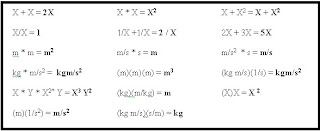Mathematical refresher

UNIT CONSISTENCY AND CONVERSIONS
Dimensionally consistent refers to the two terms that may be added or equated only ifthey have the same units
Consistency is somewhat an agreement or harmony in parts or of different things; uniformity
Example
1. A group of students ages from 19 to 22 years have an average height of 5 ft, 4 in.
What is this in centimeters? In meters?
SCALE: 12in. = 1ft
1 in. = 2.54 cm
1m = 100cm
5ft (12in. / 1ft) = 60 in. 5ft, 4 in. = 5ft + 4 in. = 60 in. + 4 in. = 64 in.
64 in.(2.54cm/ 1 in.) = 163 cm 163 cm(1m / 100cm) = 1.63 m
2. Einstein drives a car in Germany at 50 km/hr. Express this speed in meter per second.
SCALE: 1km = 1000m
1 hr = 3600s
50 km / hr (1000m/ 1km)(1hr / 3600s) = 13.89 m/ s
Scientific Notation
Scientific Notation refers to the used of powers of ten in the writing of the number. It simplifies the writing, reading, and computation of very large and very small numbers which means decreasing the possibility of error.M X 10^n
M is a single nonzero digit to the left of the decimal point
n is a positive or negative exponent
___________________________________________
Not in Scientific Notation--------------------------Scientific Notation
300,000,000 m/s---------------------------------------- 3 X 10^8 m/s
0.000,000,000,000,000,000,000,000,000,911 g----9.11 X 10^ -28 g _______________________________________________
Rules in Scientific Notation
1. Move the decimal point to the right of the first nonzero digit to determine M.2. Count the number of places the decimal point is moved. The number becomes the exponent. if the movement is to the left, n is positive; if to the right, n is negative.
Significant Figures
Significant Figures refer to those digits in a number that are certain plus one uncertain digits.Rules in Significant Figures
1. All nonzero digits are significant.345 = three significant figures
7.498 = four significant figures
9.5146 = five significant figures
2. All zeros between nonzero digits are significant.
704 = three significant figures
7056 = four significant figures
6.0613 = five significant figures
3. Zeros to the left of the first nonzero digits serve only to fix the position of the decimal point and are not significant.
0.00714 = three significant figures
0.05616 = four significant figures
0.000064913 = five significant figures
4. In a number with digits to the right of the decimal point, zeros to the right of the last nonzero digit are significant.
74.000 = three significant figures
74.0000 = four significant figures
74.00000 = five significant figures
